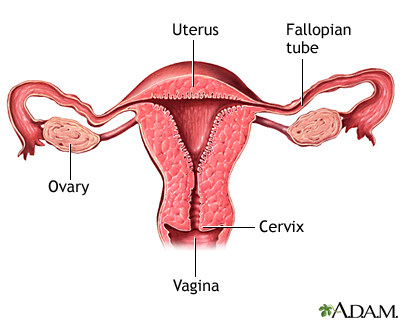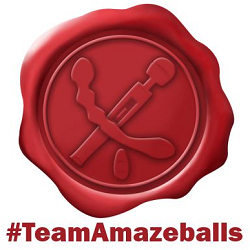This is not supposed to be a polite post. This is not supposed to be a Safe for Work post. This post is being written from the perspective of an educator who has a particular anatomy, and can answer particular questions. Why am I in a position to do this? Because I’ve actually done my research. And because I’ve actually experienced this phenomenon.
Today, I will discuss Menstruation. More commonly, you might know this as “Period(s).” I hear so many people talk about periods and menstruation, but so many folks do not know what it is or why it happens. Today, I want to fix that.
Let’s dive into some anatomy first! Below, you’ll find a picture of the internal organs that serve as the “female” side of the reproductive system.

Source: https://medlineplus.gov/ency/imagepages/8608.htm
That lovely triangle bit in the middle is our main organ of focus today. It’s called the uterus. This organ serves one primary function: to grow a child. However, it also has some secondary functions. The cervix is that gateway between the vagina and the uterus. The cervix is very sensitive, and some folks can orgasm from stimulating it! The uterus also supports other organs in the body. Without it, that empty space would let our organs (such as the bladder, colon, etc.) move around inside the abdominal cavity. This would be very bad for obvious reasons.
Since we’ve covered that bodies are not only used for making babies, I will now focus on the starring role of the uterus as incubator. It’s the main performer in the menstruation cycle. However, in order to talk about that, we must mention the fallopian tubes, as well as the ovaries. Just briefly: The ovaries make unfertilized eggs (also called ova, or singular ovum). The fallopian tubes carry those ova to the uterus.
The cycle of menstruation begins when estrogen is released (for an average of 14 days). Due to this, the lining of the uterus is thickened. This is all in preparation for the ovum to become fertilized. At this point, the ovum is set free from the ovary and sent down the fallopian tube. If the ovum meets a sperm (either in the fallopian tube or in the uterus) and is fertilized, the egg will try to implant itself on the side of the uterus and pregnancy occurs. If it fails to implant in the uterine wall, pregnancy will NOT occur.
Fun Facts Corner! After an egg has exited the fallopian tube, it’s running out of time and the window for pregnancy is a lot shorter. And if it’s IN the fallopian tube, the time it will take to implant will be a little longer. (All in all, the typical window for pregnancy is about 5 days.)
But that’s not why we are here! We are talking about when an egg travels all the way down and finds no sperm on the way to fertilize it. (Or if a fertilized egg does not implant.) At this point, the egg dissolves and the uterus (feeling quite shunned) sheds that thick lining it was building. And now, a person with a uterus experiences their period.
That is the broken down and simple version of a period. If you’re satisfied, you can stop reading here. However, there are a few questions I wanted to address for those who want more answers.
Are periods dirty?
Inherently, no. Periods are about as clean as the vagina of the person who has it. There is blood involved, so anything that can be transmitted by blood, but not sexual fluids would be new to the party. Hepatitis C is the most common virus that is transmitted by blood, but not sexual fluids. Folks with Hepatitis C should be careful of unprotected sex while bleeding occurs. With that said, there is blood involved during periods, so it’s not a sanitary experience.
When do periods start?
Typically, they start between ages 11 and 14. The average American who has a period will start it at age 12. Another way to look at it is that the average person will start their period 2 years after breast development starts.
Can folks with periods control them (when they bleed, how much, etc.)?
Technically, yes. Folks can use hormonal birth control to alter how long the bleeding lasts (from about 7 days down to 2-4 days) and when (in the month) it occurs. Some folks even stop having periods completely using this method, and so far, there are no recorded medical repercussions.
How do folks with periods handle the mess?
There are a few different options out there now. Pads are the most commonly used. Tampons are the next popular. (Personal preference is not tampons, but that’s a different article.) Menstrual cups or sponges are other options. These are less wasteful and safer than tampons, while more discreet than a large pad. None of these methods work for everyone, but everyone should find at least one that they like.
How long does the bleeding last?
In a typical case, about 7 days. There are some birth control methods that reduce this to 3 or 4 days. In some cases, IUDs stop bleeding entirely. Those folks still have hormonal cycles, they just don’t come with blood.
What is this PMS I keep hearing about?
This is a good one. PMS stands for PreMenstrual Syndrome. I hate the name of this state, as it creates a stigma against hormonal flux that is natural and even occurs in folks without uteruses.
In short, it is the result of hormonal changes in the body. It can include (but isn’t limited to) some breast tenderness, acne, mood swings, fluid retention and fatigue. This is all a result of the hormones changing and preparing the uterus to hold a baby. PMS typically occurs 1-2 weeks before bleeding.
When do cramps occur? I hear about them so much!
Cramps occur because the uterus is trying to loosen and release the lining it has created. It typically starts the day before bleeding, though in some cases, it can be the day of.
If you’re looking for more resources, I recommend these pages:
https://www.womenshealth.gov/publications/our-publications/fact-sheet/menstruation.html
For PMS: https://www.womenshealth.gov/publications/our-publications/fact-sheet/premenstrual-syndrome.html
For choosing menstrual clean up methods: http://www.healthywomen.org/content/article/tampons-pads-or-menstrual-cups-whats-right-you
This post was written by Indigo Wolfe. Indigo is a genderfluid, demisexual human who enjoys adult toys, adult beverages, and adult situations. They review all of these things at their blog, Indigo is an Adult. Recently, they’ve found a love for educating others on sexuality, sexual health and sex, so they are now pursuing degrees and a career to help with those passions.






